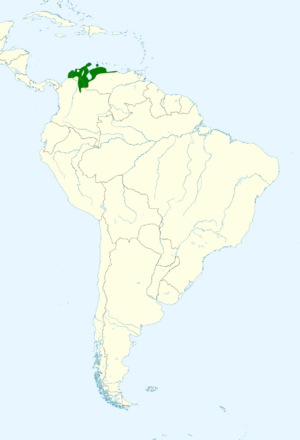Golden-winged sparrow facts for kids
The golden-winged sparrow (Arremon schlegeli) is a cool little bird. It lives in countries like Colombia and Venezuela. You can usually find it in dry forests or shrublands, which are areas with lots of bushes and small trees.
Quick facts for kids Golden-winged sparrow |
|
|---|---|
 |
|
| Conservation status | |
| Scientific classification | |
| Genus: |
Arremon
|
| Species: |
schlegeli
|
 |
|
| Synonyms | |
|
|
Contents
What Does the Golden-Winged Sparrow Look Like?
The golden-winged sparrow is easy to spot! It has a completely black head. This is special because it's the only sparrow in its area with a black head.
It also has a long, yellow bill. Its upper body is gray, and it has a patch of green on its back. Its eyes are usually brown or black.
Young sparrows have black bills. Adult sparrows have bright yellow bills. Male golden-winged sparrows have black on their face, chin, and cheeks. They also have a white throat and a gray neck.
Female sparrows have lighter, buff-colored feathers on their underside. These birds are about 150 mm long. Females weigh around 23 grams, and males weigh about 32 grams.
How Do Golden-Winged Sparrows Behave?
Golden-winged sparrows look for food on the ground or just above it. They eat seeds, fruit, and insects. They often search for food alone or in pairs.
They like forests that are growing back after being cut down. They live in both dry and humid places.
These sparrows usually breed during the wet season. This is when you hear them singing more often. Their songs are common in the early morning during April and May.
Their song is a series of high-pitched, repeated notes. People describe it as "Zeut-zeut-zeut-zee" or "Soot-soot-soot-see."
Where Do Golden-Winged Sparrows Live?
The golden-winged sparrow lives in a terrestrial ecosystem. This means it lives on land. Its homes include dry forests and shrublands. These can be in subtropical or tropical areas.
They also live in areas where forests used to be, but are now changed. These birds can be found in woodlands or dry areas. They live from lowlands up to 1400 meters high.
Within these places, they make their homes in forests. They also live in areas of new forest growth, thickets, ravines, and hillsides.
Different Kinds of Golden-Winged Sparrows
Scientists have found three different types, or subspecies, of this bird. Each subspecies lives in a slightly different place.
- A. s. schlegeli: This type lives along the Caribbean coasts of Colombia and Venezuela.
- A. s. fratruelis: You can find this one in the Serranía de Macuira. This area is on the Guajira Peninsula in northern Colombia. The fratruelis subspecies is bigger and has a longer bill than the schlegeli type.
- A. s. canidorsum: This type lives in the northern Colombian Andes mountains. Specifically, it's found on the west side of the eastern Andes in the Magdalena River Valley. This subspecies has gray upper parts and white underparts. It does not have the green patch on its back.
How Many Golden-Winged Sparrows Are There?
As of 2023, there are many golden-winged sparrows. Their population is stable, meaning it's not going up or down much.
The IUCN Red List calls this bird a "Least Concern" species. This is a good sign! It means the bird is not in danger of disappearing. It also had this classification in 2012, 2009, 2008, and 2004.
The golden-winged sparrow is not considered a vulnerable species. This is because it lives in a very large area, bigger than 20,000 square kilometers. Also, its population is steady. It hasn't dropped by more than 30% in the last ten years.
Protecting the Golden-Winged Sparrow
There are places that help protect the golden-winged sparrow. These birds have been found living in protected areas.
Even though their population is stable, it's still important to keep working on conservation. More actions might be needed in the future to make sure these birds stay safe.


